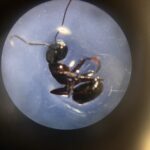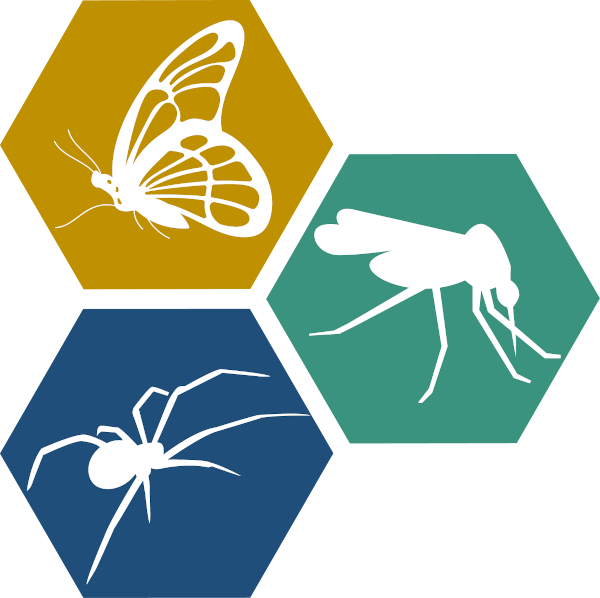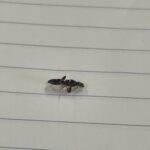Sample information |
|
| Picture |


|
|---|---|
| Location | |
| Collection date | 06/03/2024 |
| Captive / Cultivated? | Wild-caught |
| Group | Pingry School |
| Observations | The Camponotus chromaiodes was found on a dry, dusty, sunlit part of the path into the forest. The ground it was found on was littered with cracks and holes where many similar ants of its species were ducking in and out. The Camponotus chromaiodes was extremely fast and seemed to be a bit smaller for its kind, indicating that it wasn’t fully developed. Upon further observation under a microscope, we could see that the Camponotus chromaiodes had a smaller abdomen and very large antennae with a distinctly rusty color along its mesosoma and legs. |
| Putative identification | Arthropoda Insecta Hymenoptera Formicidae Camponotus Camponotus chromaiodes |
Methods |
|
| Extraction kit | DNeasy (Qiagen) blood and tissue kit |
| DNA extraction location | Abdomen |
| Single or Duplex PCR | Single Reaction |
| Gel electrophoresis system | Standard electrophoresis system |
| Buffer | TAE |
| DNA stain | SYBR Safe |
| Gel images |

|
| Protocol notes | In order to begin our DNA extraction, we had to dissect the abdomen of the Camponotus chromaiodes and wash it under running water for two minutes to remove the ethanol present. We went through the steps of cell lysis and precipitation, DNA purification, and DNA elution. After that, we checked our concentrations with a nanodrop and finished PCR while setting up our gel. After about 15-20 minutes, we checked on our gel and visualized our results (see gel above). My arthropod was in Lane 3. The top lane contained our Arthropod samples, and the bottom lane contained our Wolbachia samples, which helped us determine that our bug contained Wolbachia (see gel above). |
Results |
|
| Wolbachia presence | Yes |
| Confidence level | High |
| Explanation of confidence level | The Wolbachia band on my gel was extremely bright, and the high-quality values on my sequence confirmed that the Camponotus chromaiodes had Wolbachia. I am confident that the sequence data was very accurate, as the peaks on my sequence were very distinct. |
| Wolbachia 16S sequence | Download FASTA
Download AB1
GCTGTCGTCAGCTCGTGTCGTGAGATGTTGGGTTAAGTCCCGCAACGAGCGCAACCCTCATCCTTAGTTACCATCAGGTAATGCTGGGGACTTTAAGGAAACTGCCAGTGATAAACTGGAGGAAGGTGGGGATGATGTCAAGTCATCATGGCCCTTATGGAGTGGGCTACACACGTGCTACAATGGTGGCTACAATGGGCTGCAAAGTCGCGAGGCTAAGCTAATCCCTTAAAAGCCATCTCAGTTCGGATTGTACTCTGCAACTCGAGTGCATGAAGTTGGAATCGCTAGTAATCGTGGATCAGCACGCCACGGTGAATACGTTCTCGGGTCTTGTACACACTGCCCGTCACGCCATGGGAATTGGTTTCACTCGA
BLAST at The Wolbachia Project BLAST at NCBI
|
| Arthropod COI sequence | Download FASTA
Download AB1
GTTGGCTCCTCTATAAGAATAATCATTCGACTAGAGTTGGGATCTCCTGATTCACTAATTCTTAATGATCAAACTTTCAATACCATCGTTACAAGTCATGCTTTTATTATAATTTTTTTTATAGTTATACCTTTTATAATTGGGGGATTTGGTAATTTTTTAATTCCCCTTATACTAGGATCTCCTGATATAGCTTACCCCCGTTTAAATAACATAAGATTTTGATTACTTCCCCCATCGATCTCCTTATTAATCCTAAGAAATTTTATTAATGAAGGATCTGGAACTGGTTGGACTGTCTACCCCCCTCTATCATCAAATACCTTCCATAGTGGCCCCTCTATTGACCTGACTATCTTTTCTCTCCATATTGCTGGTATATCCTCAATTATAGGAGCAATCAATTTTATTT
BLAST at The Wolbachia Project BLAST at NCBI
|
| Summary | The Camponotus chromaiodes was found to be postive for Wolbachia. |
 European Paper Wasp
European Paper Wasp Woodworm Ant
Woodworm Ant